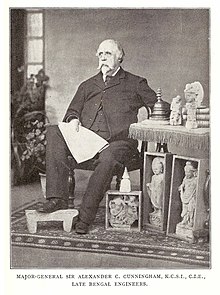Alexander Cunningham (Indologist)
Sir Alexander Cunningham (born January 23, 1814 in London , † November 28, 1893 ibid) was a British Indologist . He published several writings - mainly on the history and art of Buddhism .
life and work
Alexander Cunningham served as a British engineer officer in India ; In this role he built bridges, sketched the geographical border between Ladakh and Tibet and undertook many trips, during which he began to deal with the art and archeology of the Indian subcontinent. Around the middle of the 19th century he discovered the hill and the stupa of Mohenjo-Daro (today Sindh , Pakistan ) - at that time still in military service - but classified their adobe architecture as insignificant. In 1861 he retired with the rank of major-general of the Royal Engineers from the army service.
In 1861 he was appointed the first director of the British-Indian Antiquities Service, which, however, had to cease operations in 1865 due to lack of funds. Cunningham returned to England and wrote the first part of the Ancient Geography of India . In 1871 the Archaeological Survey of India was established, and Cunningham was appointed its first director. In this position he continued his studies and travels, and gradually his interest in Hindu art and architecture began to awaken - he was the first to study the early Gupta temples . At Sanchi he rediscovered the Satdhara and Sonari stupas . Cunningham is considered to be one of the founders of Indian archeology and numismatics . He carried out excavations in Harappa , Bharhut and Sanchi , among others .
From 1875 he was a corresponding member of the Prussian Academy of Sciences .
In 1877 the first volume of the Corpus Inscriptionum Indicarum, which was initiated by Cunningham but has since been added repeatedly, was published .
In recognition of his achievements, he was accepted as Companion (CSI) in the Order of the Star of India in 1870 and as Companion (CIE) in the Order of the Indian Empire in 1878 . On February 15, 1887, he was finally raised to the personal nobility as Knight Commander of the Order of the Indian Empire (KCIE) .
Fonts
- The Bhilsa Topes; Or, Buddhist Monuments of Central India. Smith, Elder & Co. et al., London et al. 1854, ( digitized ; reprint: Munshiram Manoharlal Publishers, New Delhi 1997, ISBN 81-215-0759-6 ).
- Coins of ancient India from the earliest times down to the seventh century AD Quaritch, London 1891, ( digitized ; reprint: Asian Educational Services, New Delhi et al. 1990, ISBN 81-206-0606-X ).
- Mahâbodhi or the Great Buddhist Temple under the Bodhi Tree at Buddha-Gaya. Allen & Co., London 1892, ( digitized ; reprint: Munshiram Manoharlal Publishers, New Delhi 1998, ISBN 81-215-0813-4 ).
Web links
Individual evidence
- ^ Members of the previous academies. Sir Alexander Cunningham. Berlin-Brandenburg Academy of Sciences and Humanities , accessed on March 11, 2015 .
- ↑ Corpus Inscriptionum Indicarum ( Memento of the original dated December 7, 2017 in the Internet Archive ) Info: The archive link was inserted automatically and has not yet been checked. Please check the original and archive link according to the instructions and then remove this notice. - Archaeological Survey of India
- ^ William A. Shaw: The Knights of England. Volume 1. Sherratt and Hughes, London 1906, p. 399 .
| personal data | |
|---|---|
| SURNAME | Cunningham, Alexander |
| ALTERNATIVE NAMES | Cunningham, Sir Alexander |
| BRIEF DESCRIPTION | British Indologist |
| DATE OF BIRTH | January 23, 1814 |
| PLACE OF BIRTH | London |
| DATE OF DEATH | November 28, 1893 |
| Place of death | London |
